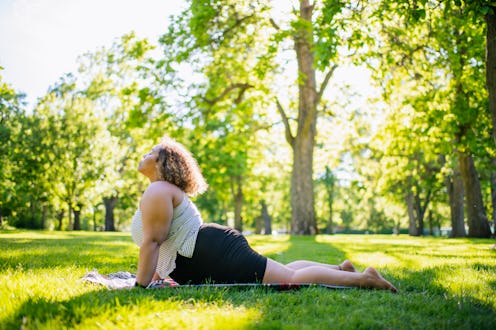
If you’re looking for a chest-opening yoga pose, a backbend, or a move that helps with digestion — among other juicy benefits — look no further than cobra pose. Cobra pose, or bhujangasana in Sanskrit, is a classic in the yoga world, says instructor Michelle Justice. It involves lying on your stomach and pushing your torso off the floor while maintaining your hip contact — just like a cobra raising its head.
Not only does cobra pose introduce a backbend into your practice, but it also opens the front of your body — and it feels really great on the hips. “Cobra pose is like a whole wellness package,” says Justice. “It's a fantastic back-strengthener and chest-opener, it stretches your shoulders, and it can also help to improve digestion by massaging the abdomen.” Try cobra pose the next time you’re constipated and it just might, uh, move things along.
This pose is a good one to try after traveling or too many hours spent sitting at a desk as a way to loosen tight hips. The backbend will do wonders for your posture, says yoga teacher Kate Ingram, RYT-500, so that you feel less scrunched. There are even a few mental health benefits to be had. Because cobra is a heart-opening pose that helps with your intake of oxygen, Ingram says it can help you feel grounded, energized — and even a little less anxious.
As a bonus, studies have found that cobra pose is helpful when it comes to reducing menstrual cramps thanks to the way it stretches and massages the lower abdomen. It’s also a goodie for lower back pain since it improves your circulation and provides a nice spine stretch, says Lindsay Payne, RYT-500, a yoga leader at Life Time Edina at Southdale. And you don’t have to be super flexible to do it — Ingram notes that it’s especially great for beginners. “It allows you to build up a lot of upper body strength, which is useful in many other poses,” she notes. Ahead, yogis explain how to do cobra pose properly so you can reap all of its many benefits.
How To Do Cobra Pose
While this pose looks a lot like upward facing dog, there are a few things that set cobra apart. “The main difference is that in upward facing dog, your thighs and hips are off the ground while your wrists are right under your shoulders,” Justice explains. “In cobra, your hips stay grounded and your hands can be forward of your shoulders, so it’s less intense.” Here, she breaks down how to get into cobra pose using good form.
- Start by lying on your stomach on a mat.
- Stretch your legs out behind you and point your toes.
- Place your hands underneath your shoulders, keeping your elbows close to your body.
- As you inhale, press your hands down.
- Lift your chest off the ground and roll your shoulders back.
- Maintain a slight bend in your elbows to avoid locking them.
- Hold for 15 to 30 seconds.
- Release as you exhale.
How To Modify Cobra Pose
According to Payne, you can make cobra pose less challenging by allowing your lower half to remain nice and passive — so no straightening your toes or pushing into your hips. “Straighten your arms a little or a lot, depending on how much energy feels good to put into the shape,” she tells Bustle. You can also keep your forearms flat on the floor or support yourself with a blanket or pillow.
To add a bit more to your cobra, Payne suggests pressing into your hands so that your arms elongate and your chest broadens. “Yogis can also get their lower half involved by pointing their toes and feeding energy and sensation down their legs,” she tells Bustle.
Common Cobra Pose Mistakes To Avoid
It’s tempting to push really hard into your hands while doing cobra pose, but Ingram says there’s no need. “You are still getting all the benefits [from the gentle variation] without straining,” she tells Bustle.
While you’re at it, keep an eye on your shoulders. If they round forward, it’ll close off your breath, which negates all the benefits of chest-opening postures like this one. As long as you do cobra with good form, you’ll reap its perks — and feel a whole lot more open once you get off your mat.
Studies referenced:
Rakhshaee, Z. (2011). Effect of three yoga poses (cobra, cat and fish poses) in women with primary dysmenorrhea: a randomized clinical trial. J Pediatr Adolesc Gynecol. doi: 10.1016/j.jpag.2011.01.059.
Sherman, KJ. (2010). Comparison of yoga versus stretching for chronic low back pain: protocol for the Yoga Exercise Self-care (YES) trial. Trials. doi: 10.1186/1745-6215-11-36.
Sources:
Michelle Justice, yoga instructor
Kate Ingram, RYT-500, yoga instructor
Lindsay Payne, RYT-500, yoga instructor